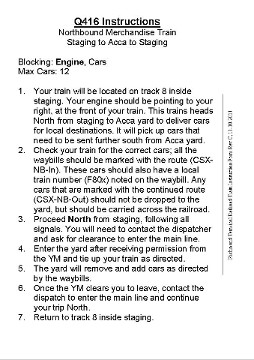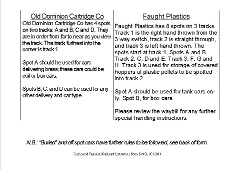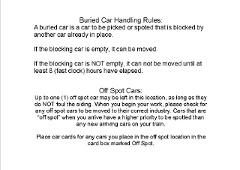Operating Scheme
In my opinion, one of the major pieces in play to make an operating session fun is the ability to articulate your operating scheme. Now, this covers the gamut of paperwork, job aids, briefings, docents, and the like, so we are talking about a very broad subject here, so let's hit some high points to break this into easier chunks.
Now, on the main page of the operations section, I touched upon a couple of these points and I'll go through specifics here shortly in the next section to cover what I do on the RRTR, but for right now, let's hit the high points like I promised.
A couple of what I will call foundation pieces work with any scheme. Here's what I think they are: (and these aren't in any particular order)
- Pre-Session Briefing
- Good signage on railroad
- clear paperwork
- realistic expectations
The Brief
Here's where you give your crew the basic information they need. "We will be running schedule foo today. This is the schedule that has BigTrain3 on it, so be on the lookout for that. Crews, be sure to make your OS reports to the dispatcher. Please, keep food and drinks in the crew lounge." I'd shoot for about 4 or 5 minutes and hit the most important stuff. Last thing to talk about is jobs - who is going to do what job. If you assign crew members, you recap those facts (since you pre-warned everybody, right?) and then get the session going. Some folks do the briefing in the train room; others do it elsewhere and at the conclusion of the brief, have everybody head to the layout. Whatever works for you the best, but you do need to brief everybody.
Clear Paperwork
Whatever you use, I recommend you print it out. Handwritten documentation can be difficult to read and it is easy to fall off after doing car card number 100 and introduce inconsistencies which then forces people to either seek you out for guidance or make a guess and do the wrong thing. Then you get to discover that when you stage for the next session - "Why does industry A not have any cars?"
Signage
This goes hand in hand with clear paperwork. The ability of crews to tell where they are, and where they need to go, is very important. It helps them do their job efficiently and it lets everybody pinpoint problem spots.
Realistic Expectations
This covers a couple of things; one of them is to keep your crew busy, but not so busy they'd rather be at work. :) An example of the other thing is that if you expect a local train to make it across the railroad in a single session, that they are able to complete the work. In other words, don't assign 4 hours of work in a 2 hour session. The exception to this dictum is if you have a scheme that allows for people to park their train wherever when the session ends. If you do, you know who you are. :)
On the RRTR:
 Since I am a car card and waybill system, I've built my scheme and schedule around that, including my job aids.
Since I am a car card and waybill system, I've built my scheme and schedule around that, including my job aids.
I provide each crew with an index card sized set of instructions. It includes the train number, direction of travel, where it originates and terminates, if there is limit on the number of cars that should be on the train, blocking order and then a step by step list of instructions to give the crew a good overview of what to expect.

 For the local crews, each switching location on the railroad has both a map provided and a instruction card. The instruction card has basic rules about buried, off spot or car spot restrictions.
For the local crews, each switching location on the railroad has both a map provided and a instruction card. The instruction card has basic rules about buried, off spot or car spot restrictions.
 The map details the industries, their component spots, and turnout numbers, if needed, to inform the dispatcher which turnout they might need changed.
The map details the industries, their component spots, and turnout numbers, if needed, to inform the dispatcher which turnout they might need changed.
One thing I have done to my maps and other documents is to put a revision number and date on them. This is primarily for me so I can make sure that if I update the documentation, I have some idea on when the paper I have on the layout was done.
 Since I am a car card and waybill system, I've built my scheme and schedule around that, including my job aids.
Since I am a car card and waybill system, I've built my scheme and schedule around that, including my job aids.

